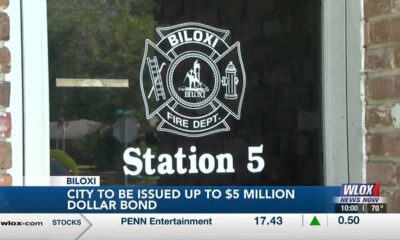Kaiser Health News
$50 Billion in Opioid Settlement Cash Is on the Way. We’re Tracking How It’s Spent.
by Aneri Pattani
Thu, 30 Mar 2023 09:00:00 +0000
More than $50 billion in settlement funds is being delivered to thousands of state and local governments from companies accused of flooding their communities with opioid painkillers that have left millions addicted or dead.
That's an enormous amount of money — double NASA's budget and five times the revenue of an NBA season.
But how that massive windfall is being deployed and how future dollars will be spent seem to be shrouded in mystery. Reporting requirements are scant, and documents filed so far are often so vague as to be useless.
Most of the settlements stipulate that states must spend at least 85% of the money they will receive over the next 15 years on addiction treatment and prevention. But defining those concepts depends on stakeholders' views — and state politics. To some, it might mean opening more treatment sites. To others, buying police cruisers.
Those affected by the opioid epidemic and those working to fight it have an array of ideas: To Marianne Sinisi, who lost her 26-year-old son, Shawn, to overdose in western Pennsylvania, the settlement funds are “blood money” that she hopes can spare other parents similar grief. To Steve Alsum, who works with people who use drugs in Grand Rapids, Michigan, it's a chance to finally reach all those in need. And to David Garbark, who is in recovery from opioid addiction, it's a way to give others in his eastern North Carolina community a second chance, too.
Spending the money effectively and equitably is a tall order, given the persistence and complexity of addiction, which affects individuals and communities, and is the topic of heated debates in scientific research, social services, politics, criminal justice, and even at kitchen tables.
What's more, many states are not being transparent about where the funds are going and who will benefit. An investigation by KHN and Christine Minhee, founder of OpioidSettlementTracker.com, concluded only 12 states have committed to detailed public reporting of all their spending.
The analysis involved scouring hundreds of legal documents, laws, and public statements to determine how each state is divvying up its settlement money among state agencies, city and county governments, and councils that oversee dedicated trusts. The next step was to determine the level and detail of public reporting required. The finding: Few states promise to report in ways that are accessible to the average person, and many are silent on the issue of transparency altogether.
More than $3 billion has gone out to state and local governments so far. KHN will be following how that cash — and the billions set to arrive in coming years — is used.
Per most of the settlements, governments are required to report only on the 15% of the money that can be used for things unrelated to the epidemic, like offsetting budget shortfalls or fixing old roads. As of March 28, only three states and counties had filed such reports. Although they listed dollar amounts, none said precisely how the money was spent.
State and local governments can enact more rigorous reporting protocols — for example, requiring a publicly available list of every place that receives money and for what purpose — but few have so far.
Loading…
Left in the Dark
More than 250,000 Americans have died of overdoses from prescription opioids, which were aggressively promoted as painkillers and distributed by a host of health care companies, including Johnson & Johnson, AmerisourceBergen, McKesson, and Walmart. The settlements are meant to compensate and remediate the effects of that corporate behavior.
But many people whose lives have been upended are again feeling traumatized.
Sinisi said she and other parents who've lost kids to addiction have been left in the dark or, worse, treated like nuisances by officials in charge of the money.
“They want to look at you as this angry parent who lost a child,” she said, “rather than a concerned citizen who wants to see a difference made for other mothers, fathers, and their children.”
In Michigan, even the state's Opioid Advisory Commission, which is tasked with evaluating the use of settlement money, has struggled to track the cash.
For six months after the state legislature allotted $39 million of settlement funds to the health department last summer, little information was made public about how that money would be spent. No news releases. No way for organizations to apply for funds.
“We can't really identify the impact of those dollars if we don't know how they're being used,” said Dr. Cara Poland, the commission's chair and an addiction-medicine doctor.
With scant oversight nationwide, many people fear dollars may flow to efforts that research has proven mostly useless but jibe with the local political bent, like arresting people who use drugs, expanding jails, and favoring abstinence-only recovery over medications. They may go to the loudest bidder, with companies promising to find the next groundbreaking treatment and rehab facilities — some with shoddy track records — eyeing the cash.
Not to mention concerns that money will flow to activities that have little to nothing to do with opioid treatment: building new stadiums or public schools. Back in the '90s, these day-to-day budget priorities consumed most of what states won from cigarette companies in the national tobacco settlement, leaving little for anti-smoking programs.
The opioid settlement funds will be different, say state attorneys general who fought for them. In addition to requiring at least 85% of the money be used on opioid-related expenses, most agreements include a list of suggested interventions like increasing addiction treatment for the uninsured and expanding recovery housing.
“We wanted to give states flexibility on what approaches they wanted to adopt,” while ensuring money didn't go to “provide corporate tax relief” as the tobacco dollars did, said North Carolina Attorney General Josh Stein, who led negotiations for the national settlements.
But enforcement of the 85% standard is, oddly, left to the companies that paid out the money. They are unlikely to be vigilant, legal experts say. The money is committed already and, for many of these multibillion-dollar companies, the settlements are chump change. For example, Johnson & Johnson is set to pay $5 billion over nine years, but the company reported sales of nearly $95 billion in the past year alone.
An Emerging Picture
As the checks start to trickle in, a handful of states are committed to transparency while others seem to be falling short. Missouri has promised to report all its spending in online reports so that anyone can see who receives money, how much, and for what programs. New Hampshire already has posted reports online, and Colorado has created a public dashboard to track how funds are used.
Other states, like Nevada, have taken a middle-of-the-road approach, requiring that recipients report to the legislature or another oversight body, but not ensuring the reports will go public. Some states require audits but don't promise to list specific expenses. And others allow the public to request records but won't provide them automatically.
Then there are states hit hard by the opioid epidemic like Michigan and Ohio, where problems with transparency are already emerging. Each state is expecting to receive at least $1 billion.
When Poland, of Michigan's Opioid Advisory Commission, realized she was getting little information on how the state's funds were being spent, her commission decided to use its first annual report — published this month — to demand better. “Timely and transparent reporting” to the public is “an ethical responsibility,” it said, calling on lawmakers to enact greater oversight for settlement cash recipients and create a public dashboard to track spending.
KHN interviewed nearly a dozen people and filed a public records request to uncover how the state health department is spending the initial settlement funds allocation of $39 million.
A budget document obtained by KHN shows that as of Jan. 9, the Michigan Department of Health and Human Services had contracted $3.9 million in settlement funds to 35 grantees. Most are local health departments or syringe service programs that the state health department has previously funded.
An additional $27 million is set aside for particular interventions, such as growing the addiction treatment workforce, expanding recovery housing, and mitigating the harms of opioid use with medications like naloxone.
And, after KHN's inquiries, the department released a statement that listed similar priorities.
Those initiatives make sense to Jonathan Stoltman, director of the Michigan-based Opioid Policy Institute, which researches stigma and digital privacy in addiction treatment. But he would have liked to have known about them in advance and to have had a clear process laid out for groups to apply for the funds. Otherwise, organizations that are well positioned to use the money to help those most in need may miss a once-in-a-lifetime chance to scale up their work and save lives.
Last summer, when Stoltman inquired about applying for the funds, the health department told him to submit a “high level proposal” to “share around,” according to emails reviewed by KHN.
“Anything that is backdoor scares me,” said Stoltman. “I got lucky that I found who to talk to, even if it didn't go anywhere.”
Steve Alsum, executive director of the Grand Rapids Red Project, which was awarded about $266,000 to improve the health of people who use drugs, said he expected the state to have an application process with scoring criteria to explain why certain groups were chosen. But, he said, “it hasn't been clear who is making the decision and how it's made.”
Jared Welehodsky, who leads the department's efforts related to the settlement, said it is in the process of releasing several competitive grant applications for the bulk of the money. That didn't happen sooner because most payments didn't arrive until the end of 2022 and “we didn't want to comment on how the money was going out when we didn't have money to go out,” he said.
Talk of Keeping the Public Out
In Newark, Ohio, Linda Mossholder, 75, has been inquiring about the settlement dollars at City Council meetings since last summer. As a volunteer with Newark Homeless Outreach, which serves weekly free lunches, she encounters many people who use drugs and wants to see the money help them.
The proud owner of a T-shirt that reads, “Your first mistake is thinking I'm just an old lady,” Mossholder has followed up with emails, voicemails, and public records requests. But she hasn't gotten a clear answer about how the city plans to use the nearly $50,000 it's already received.
In January, Mossholder said, the city's director of public service finally told her the plan was to allocate settlement cash to first responders for naloxone. But when KHN filed public records requests to confirm, City Auditor Ryan Bubb wrote, “No funds have been allocated or spent.”
Meanwhile, in northeastern Ohio, a regional board that will control millions of settlement dollars spent a February meeting discussing whether the public should be allowed to access meeting recordings at all.
“I wouldn't open it up to the public, honestly,” said Judy Moran, a board member who represents Eastlake, according to a recording of the meeting obtained by KHN. Other board members asked if their gatherings were subject to the state's open-meeting laws.
Moran later told KHN, “Of course the public has a right to know how these funds are disbursed,” but she said she worried recordings would allow people to take words “out of context.”
In Ohio at least, that may not be a choice for much longer.
A lawsuit brought by Harm Reduction Ohio to open the meetings of a separate board — the OneOhio Recovery Foundation, which oversees the lion's share of the state's expected $1 billion — is working its way through the courts. A local judge this month rejected the foundation's request to dismiss the lawsuit, writing that “the public deserves transparency.”
But OneOhio spokesperson Connie Luck said the foundation is a “private, nonprofit organization, and not a government agency.” It has so far allowed public attendance at meetings, but has said it is not required to do so.
The final ruling in this lawsuit, which is the first of its kind on opioid settlement funds, will set a precedent for the public's right to information nationally.
In some parts of the country, the prospect of dollars to treat a long-underfunded epidemic brings hope, said Tricia Christensen, who works at a nonprofit tracking settlement funds across Appalachia. When people know what's happening, it not only deters misuse but can reveal surprising successes, she said.
That knowledge is empowering.
“These funds are the cavalry coming in. You're finally getting relief after suffering alone for so long,” said Crystal Glass, of southwestern Virginia, who is in recovery from opioid and meth use and now works as a peer recovery specialist.
She hopes officials will involve people affected by addiction in their decisions.
As she put it: Transparency “is letting everyone — I mean everyone — know they can be part of this.”
KHN's Colleen DeGuzman and Megan Kalata contributed to this report.
By: Aneri Pattani
Title: $50 Billion in Opioid Settlement Cash Is on the Way. We're Tracking How It's Spent.
Sourced From: khn.org/news/article/opioid-drugmakers-settlement-funds-50-billion-dollars-khn-investigation-payback/
Published Date: Thu, 30 Mar 2023 09:00:00 +0000
Kaiser Health News
Tire Toxicity Faces Fresh Scrutiny After Salmon Die-Offs
Jim Robbins
Wed, 24 Apr 2024 09:00:00 +0000
For decades, concerns about automobile pollution have focused on what comes out of the tailpipe. Now, researchers and regulators say, we need to pay more attention to toxic emissions from tires as vehicles roll down the road.
At the top of the list of worries is a chemical called 6PPD, which is added to rubber tires to help them last longer. When tires wear on pavement, 6PPD is released. It reacts with ozone to become a different chemical, 6PPD-q, which can be extremely toxic — so much so that it has been linked to repeated fish kills in Washington state.
The trouble with tires doesn't stop there. Tires are made primarily of natural rubber and synthetic rubber, but they contain hundreds of other ingredients, often including steel and heavy metals such as copper, lead, cadmium, and zinc.
As car tires wear, the rubber disappears in particles, both bits that can be seen with the naked eye and microparticles. Testing by a British company, Emissions Analytics, found that a car's tires emit 1 trillion ultrafine particles per kilometer driven — from 5 to 9 pounds of rubber per internal combustion car per year.
And what's in those particles is a mystery, because tire ingredients are proprietary.
“You've got a chemical cocktail in these tires that no one really understands and is kept highly confidential by the tire manufacturers,” said Nick Molden, CEO of Emissions Analytics. “We struggle to think of another consumer product that is so prevalent in the world and used by virtually everyone, where there is so little known of what is in them.”
Regulators have only begun to address the toxic tire problem, though there has been some action on 6PPD.
The chemical was identified by a team of researchers, led by scientists at Washington State University and the University of Washington, who were trying to determine why coho salmon returning to Seattle-area creeks to spawn were dying in large numbers.
Working for the Washington Stormwater Center, the scientists tested some 2,000 substances to determine which one was causing the die-offs, and in 2020 they announced they'd found the culprit: 6PPD.
The Yurok Tribe in Northern California, along with two other West Coast Native American tribes, have petitioned the Environmental Protection Agency to prohibit the chemical. The EPA said it is considering new rules governing the chemical. “We could not sit idle while 6PPD kills the fish that sustain us,” said Joseph L. James, chairman of the Yurok Tribe, in a statement. “This lethal toxin has no place in any salmon-bearing watershed.”
California has begun taking steps to regulate the chemical, last year classifying tires containing it as a “priority product,” which requires manufacturers to search for and test substitutes.
“6PPD plays a crucial role in the safety of tires on California's roads and, currently, there are no widely available safer alternatives,” said Karl Palmer, a deputy director at the state's Department of Toxic Substances Control. “For this reason, our framework is ideally suited for identifying alternatives to 6PPD that ensure the continued safety of tires on California's roads while protecting California's fish populations and the communities that rely on them.”
The U.S. Tire Manufacturers Association says it has mobilized a consortium of 16 tire manufacturers to carry out an analysis of alternatives. Anne Forristall Luke, USTMA president and CEO, said it “will yield the most effective and exhaustive review possible of whether a safer alternative to 6PPD in tires currently exists.”
Molden, however, said there is a catch. “If they don't investigate, they aren't allowed to sell in the state of California,” he said. “If they investigate and don't find an alternative, they can go on selling. They don't have to find a substitute. And today there is no alternative to 6PPD.”
California is also studying a request by the California Stormwater Quality Association to classify tires containing zinc, a heavy metal, as a priority product, requiring manufacturers to search for an alternative. Zinc is used in the vulcanization process to increase the strength of the rubber.
When it comes to tire particles, though, there hasn't been any action, even as the problem worsens with the proliferation of electric cars. Because of their quicker acceleration and greater torque, electric vehicles wear out tires faster and emit an estimated 20% more tire particles than the average gas-powered car.
A recent study in Southern California found tire and brake emissions in Anaheim accounted for 30% of PM2.5, a small-particulate air pollutant, while exhaust emissions accounted for 19%. Tests by Emissions Analytics have found that tires produce up to 2,000 times as much particle pollution by mass as tailpipes.
These particles end up in water and air and are often ingested. Ultrafine particles, even smaller than PM2.5, are also emitted by tires and can be inhaled and travel directly to the brain. New research suggests tire microparticles should be classified as a pollutant of “high concern.”
In a report issued last year, researchers at Imperial College London said the particles could affect the heart, lungs, and reproductive organs and cause cancer.
People who live or work along roadways, often low-income, are exposed to more of the toxic substances.
Tires are also a major source of microplastics. More than three-quarters of microplastics entering the ocean come from the synthetic rubber in tires, according to a report from the Pew Charitable Trusts and the British company Systemiq.
And there are still a great many unknowns in tire emissions, which can be especially complex to analyze because heat and pressure can transform tire ingredients into other compounds.
One outstanding research question is whether 6PPD-q affects people, and what health problems, if any, it could cause. A recent study published in Environmental Science & Technology Letters found high levels of the chemical in urine samples from a region of South China, with levels highest in pregnant women.
The discovery of 6PPD-q, Molden said, has sparked fresh interest in the health and environmental impacts of tires, and he expects an abundance of new research in the coming years. “The jigsaw pieces are coming together,” he said. “But it's a thousand-piece jigsaw, not a 200-piece jigsaw.”
This article was produced by KFF Health News, which publishes California Healthline, an editorially independent service of the California Health Care Foundation.
KFF Health News is a national newsroom that produces in-depth journalism about health issues and is one of the core operating programs at KFF—an independent source of health policy research, polling, and journalism. Learn more about KFF.
USE OUR CONTENT
This story can be republished for free (details).
——————————
By: Jim Robbins
Title: Tire Toxicity Faces Fresh Scrutiny After Salmon Die-Offs
Sourced From: kffhealthnews.org/news/article/tire-toxicity-salmon-die-offs-research-6ppd/
Published Date: Wed, 24 Apr 2024 09:00:00 +0000
Did you miss our previous article…
https://www.biloxinewsevents.com/ftc-chief-says-tech-advancements-risk-health-care-price-fixing/
Kaiser Health News
FTC Chief Says Tech Advancements Risk Health Care Price Fixing
Julie Rovner, KFF Health News and David Hilzenrath
Tue, 23 Apr 2024 13:13:59 +0000
New technologies are making it easier for companies to fix prices and discriminate against individual consumers, the Biden administration's top consumer watchdog said Tuesday.
Algorithms make it possible for companies to fix prices without explicitly coordinating with one another, posing a new test for regulators policing the market, said Lina Khan, chair of the Federal Trade Commission, during a media event hosted by KFF.
“I think we could be entering a somewhat novel era of pricing,” Khan told reporters.
Khan is regarded as one of the most aggressive antitrust regulators in recent U.S. history, and she has paid particular attention to the harm that technological advances can pose to consumers. Antitrust regulators at the FTC and the Justice Department set a record for merger challenges in the fiscal year that ended Sept. 30, 2022, according to Bloomberg News.
Last year, the FTC successfully blocked biotech company Illumina's over $7 billion acquisition of cancer-screening company Grail. The FTC, Justice Department, and Health and Human Services Department launched a website on April 18, healthycompetition.gov, to make it easier for people to report suspected anticompetitive behavior in the health care industry.
The American Hospital Association, the industry's largest trade group, has often criticized the Biden administration's approach to antitrust enforcement. In comments in September on proposed guidance the FTC and Justice Department published for companies, the AHA said that “the guidelines reflect a fundamental hostility to mergers.”
Price fixing removes competition from the market and generally makes goods and services more expensive. The agency has argued in court filings that price fixing “is still illegal even if you are achieving it through an algorithm,” Khan said. “There's no kind of algorithmic exemption to the antitrust laws.”
By simply using the same algorithms to set prices, companies can effectively charge the same “even if they're not, you know, getting in a back room and kind of shaking hands and setting a price,” Khan said, using the example of residential property managers.
Khan said the commission is also scrutinizing the use of artificial intelligence and algorithms to set prices for individual consumers “based on all of this particular behavioral data about you: the websites you visited, you know, who you had lunch with, where you live.”
And as health care companies change the way they structure their businesses to maximize profits, the FTC is changing the way it analyzes behavior that could hurt consumers, Khan said.
Hiring people who can “help us look under the hood” of some inscrutable algorithms was a priority, Khan said. She said it's already paid off in the form of legal actions “that are only possible because we had technologists on the team helping us figure out what are these algorithms doing.”
Traditionally, the FTC has policed health care by challenging local or regional hospital mergers that have the potential to reduce competition and raise prices. But consolidation in health care has evolved, Khan said.
Mergers of systems that don't overlap geographically are increasing, she said. In addition, hospitals now often buy doctor practices, while pharmacy benefit managers start their own insurance companies or mail-order pharmacies — or vice versa — pursuing “vertical integration” that can hurt consumers, she said.
The FTC is hearing increasing complaints “about how these firms are using their monopoly power” and “exercising it in ways that's resulting in higher prices for patients, less service, as well as worse conditions for health care workers,” Khan said.
Policing Noncompetes
Khan said she was surprised at how many health care workers responded to the commission's recent proposal to ban “noncompete” clauses — agreements that can prevent employees from moving to new jobs. The FTC issued its final rule banning the practice on Tuesday. She said the ban was aimed at low-wage industries like fast food but that many of the comments in favor of the FTC's plan came from health professions.
Health workers say noncompete agreements are “both personally devastating and also impeded patient care,” Khan said.
In some cases, doctors wrote that their patients “got really upset because they wanted to stick with me, but my hospital was saying I couldn't,” Khan said. Some doctors ended up commuting long distances to prevent the rest of their families from having to move after they changed jobs, she said.
KFF Health News is a national newsroom that produces in-depth journalism about health issues and is one of the core operating programs at KFF—an independent source of health policy research, polling, and journalism. Learn more about KFF.
USE OUR CONTENT
This story can be republished for free (details).
——————————
By: Julie Rovner, KFF Health News and David Hilzenrath
Title: FTC Chief Says Tech Advancements Risk Health Care Price Fixing
Sourced From: kffhealthnews.org/news/article/ftc-lina-khan-price-fixing-noncompete-mergers/
Published Date: Tue, 23 Apr 2024 13:13:59 +0000
Did you miss our previous article…
https://www.biloxinewsevents.com/unsheltered-people-are-losing-medicaid-in-redetermination-mix-ups/
Kaiser Health News
Unsheltered People Are Losing Medicaid in Redetermination Mix-Ups
Aaron Bolton, MTPR
Tue, 23 Apr 2024 09:00:00 +0000
KALISPELL, Mont. — On a cold February morning at the Flathead Warming Center, Tashya Evans waited for help with her Medicaid application as others at the shelter got ready for the day in this northwestern Montana city.
Evans said she lost Medicaid coverage in September because she hadn't received paperwork after moving from Great Falls, Montana. She has had to forgo the blood pressure medication she can no longer pay for since losing coverage. She has also had to put off needed dental work.
“The teeth broke off. My gums hurt. There's some times where I'm not feeling good, I don't want to eat,” she said.
Evans is one of about 130,000 Montanans who have lost Medicaid coverage as the state reevaluates everyone's eligibility following a pause in disenrollments during the covid-19 pandemic. About two-thirds of those who were kicked off state Medicaid rolls lost coverage for technical reasons, such as incorrectly filling out paperwork. That's one of the highest procedural disenrollment rates in the nation, according to a KFF analysis.
Even unsheltered people like Evans are losing their coverage, despite state officials saying they would automatically renew people who should still qualify by using Social Security and disability data.
As other guests filtered out of the shelter that February morning, Evans sat down in a spare office with an application counselor from Greater Valley Health Clinic, which serves much of the homeless population here, and recounted her struggle to reenroll.
She said that she had asked for help at the state public assistance office, but that the staff didn't have time to answer her questions about which forms she needed to fill out or to walk her through the paperwork. She tried the state's help line, but couldn't get through.
“You just get to the point where you're like, ‘I'm frustrated right now. I just have other things that are more important, and let's not deal with it,'” she said.
Evans has a job and spends her free time finding a place to sleep since she doesn't have housing. Waiting on the phone most of the day isn't feasible.
There's no public data on how many unhoused people in Montana or nationwide have lost Medicaid, but homeless service providers and experts say it's a big problem.
Those assisting unsheltered people who have lost coverage say they spend much of their time helping people contact the Montana Medicaid office. Sorting through paperwork mistakes is also a headache, said Crystal Baker, a case manager at HRDC, a homeless shelter in Bozeman.
“We're getting mail that's like, ‘Oh, this needs to be turned in by this date,' and that's already two weeks past. So, now we have to start the process all over again,” she said. “Now, they have to wait two to three months without insurance.”
Montana health officials told NPR and KFF Health News in a statement that they provided training to help homeless service agencies prepare their clients for redetermination.
Federal health officials have warned Montana and some other conservative states against disenrolling high rates of people for technicalities, also known as procedural disenrollment. They also warned states about unreasonable barriers to accessing help, such as long hold times on help lines. The Centers for Medicare & Medicaid Services said if states don't reduce the rate of procedural disenrollments, the agency could force them to halt their redetermination process altogether. So far, CMS hasn't taken that step.
Charlie Brereton, the director of the Montana health department, resisted calls from Democratic state lawmakers to pause the redetermination process. Redetermination ended in January, four months ahead of the federal deadline.
“I'm confident in our redetermination process,” Brereton told lawmakers in December. “I do believe that many of the Medicaid members who've been disenrolled were disenrolled correctly.
Health industry observers say that both liberal-leaning and conservative-leaning states are kicking homeless people off their rolls and that the redetermination process has been chaotic everywhere. Because of the barriers that unsheltered people face, it's easy for them to fall through the cracks.
Margot Kushel, a physician and a homeless researcher at the University of California-San Francisco, said it may not seem like a big deal to fill out paperwork. But, she said, “put yourself in the position of an elder experiencing homelessness,” especially those without access to a computer, phone, or car.
If they still qualify, people can usually get their Medicaid coverage renewed — eventually — and it may reimburse patients retroactively for care received while they were unenrolled.
Kushel said being without Medicaid for any period can be particularly dangerous for people who are homeless. This population tends to have high rates of chronic health conditions.
“Being out of your asthma medicine for three days can be life-threatening. If you have high blood pressure and you suddenly stop your medicine, your blood pressure shoots up, and your risk of having a heart attack goes way up,” she said.
When people don't understand why they're losing coverage or how to get it back, that erodes their trust in the medical system, Kushel said.
Evans, the homeless woman, was able to get help with her application and is likely to regain coverage.
Agencies that serve unhoused people said it could take years to get everyone who lost coverage back on Medicaid. They worry that those who go without coverage will resort to using the emergency room rather than managing their health conditions proactively.
Baker, the case manager at the Bozeman shelter, set up several callbacks from the state Medicaid office for one client. The state needed to interview him to make sure he still qualified, but the state never called.
“He waited all day long. By the fifth time, it was so stressful for him, he just gave up,” she said.
That client ended up leaving the Bozeman area before Baker could convince him it was worth trying to regain Medicaid.
Baker worries his poor health will catch up with him before he decides to try again.
This article is from a partnership that includes MTPR, NPR, and KFF Health News.
——————————
By: Aaron Bolton, MTPR
Title: Unsheltered People Are Losing Medicaid in Redetermination Mix-Ups
Sourced From: kffhealthnews.org/news/article/unsheltered-people-losing-medicaid-redetermination-paperwork/
Published Date: Tue, 23 Apr 2024 09:00:00 +0000
-
SuperTalk FM7 days ago
Chance of parole denied for man who killed 3 Choctaw Indian tribal members
-
SuperTalk FM6 days ago
2 arrested after missing man’s body found on side of Mississippi highway
-
Mississippi News5 days ago
What this means for local schools
-
228Sports3 days ago
From Heartbreak to Hoop Dreams: Pascagoula Panthers Springboard from Semifinal Setback to College Courts
-
Kaiser Health News7 days ago
To Stop Fentanyl Deaths in Philadelphia, Knocking on Doors and Handing Out Overdose Kits
-
Mississippi News3 days ago
2 dead, 6 hurt in shooting at Memphis, Tennessee block party: police
-
Mississippi News6 days ago
Willis Miller sentenced to 45 years in prison, mandatory
-
Mississippi News3 days ago
Forest landowners can apply for federal emergency loans


































